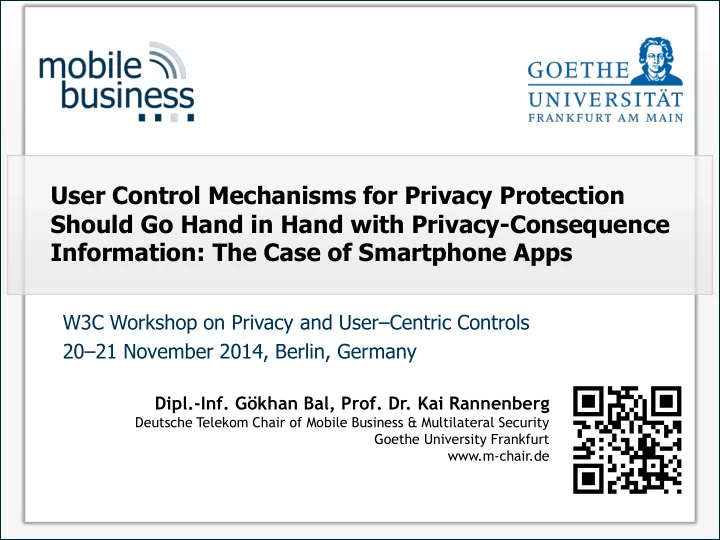

User Control Mechanisms for Privacy Protection Should Go Hand in Hand with Privacy-Consequence Information: The Case of Smartphone Apps W3C Workshop on Privacy and User – Centric Controls 20 – 21 November 2014, Berlin, Germany Dipl.-Inf. Gökhan Bal, Prof. Dr. Kai Rannenberg Deutsche Telekom Chair of Mobile Business & Multilateral Security Goethe University Frankfurt www.m-chair.de
1 MOTIVATION 20.11.2014 2
1. Motivation Two Perspectives on Privacy Protection Privacy Protection as a Decision-making as a calculus of risks Process (Brunk 2005) and benefits (Culnan and Armstrong 1999) Awareness Behavioral Reactions (including disclosures) Detection Prevention Privacy Calculus Response Risks / Costs Benefits Recovery 20.11.2014 3
1. Motivation Problems Benefits are what drive users towards service use. Privacy thoughts most often are only a „supporting actor“ in users’ decision -making. More effective privacy-risk communication is needed to help users understand the consequences of behavior. Call: integrate (privacy-)consequence information into user-control mechanisms. 20.11.2014 4
2 THE CASE OF SMARTPHONE APPS 20.11.2014 5
2 The Case of Smartphone Apps Privacy Risks of Smartphone App Usage Apps are useful and provide utility. APIs (e.g. geolocation API) as …enabler of utility. …threat to user privacy. Negative examples: „Path“ & „Brightest Flashlight“ Lack of risk transparency and “hidden” information flows lead to a bias in users’ risk perceptions. Explicitness regarding consequences can help (Laughery et al. 1993). 20.11.2014 6
2 The Case of Smartphone Apps Privacy Risks of Smartphone App Usage First-order privacy risk: Second-order privacy risk: apps can access a multiplicity of sensitive Profiling: aggregated smartphone data resources (enabled to provide utility). can be used to generate meaningful most apps have Internet access. information about the user (predict user traits, personality traits, movement information flows often without notice. patters) 2 risk: implicit revelations of risk: leakage of sensitive data 1 . private information due to data-aggregation potentials. Data Mining Data Item A Receiver X Data Item A New Information Receiver X Data Item B Data Item B Receiver Y 2 e.g., Kwapisz et al. 2010; Weiss and Lockhart 2011; Chittaranjan et al. 2011; Min et al. 2013; González et 1 e.g., Egele et al. 2011; Enck et al. 2010 al. 2008; Phithakkitnukoon et al. 2010. 20.11.2014 7
2 The Case of Smartphone Apps Current Privacy-Risk Communication Current privacy risk information is… … static, … coarse -grained & technical, … timed inappropriately, … ignored largely, … does not support informed decision-making. 20.11.2014 8
2 The Case of Smartphone Apps Suggested New Approaches (1/2): Google Play Study 20.11.2014 9
2 The Case of Smartphone Apps Suggested New Approaches (2/2): Android Study Styx Inference Styx Notification Styx Dashboard Screen 20.11.2014 10
2 The Case of Smartphone Apps Results of Two User Studies (Summary) A consequence-based privacy- risk communication leads to: increased privacy and risk awareness, better comprehension of risks, better comparison of apps, privacy as a stronger decision factor, safer app choices. 20.11.2014 11
CHALLENGES & RECOMMENDATIONS 20.11.2014 12
3 Challenges & Recommendations Challenges Challenge Description • 1. Conceptualization of Identification and conceptualization of consequences • Privacy Consequences Consideration of context, scenario, etc. • Positive vs. negative consequences • 2. Consider functionality Consideration of the purpose of an application (“demand level”) • and context of data access Context of access (e.g. background information flows vs. active UI) 3. Monitor data-access The actual data-access behavior of an app is significantly influencing behavior of apps the privacy intrusiveness of an app (what resources? how frequent? what combinations? interactions with other apps?); TaintDroid as an example (Enck et al. 2010). 4. Consider Privacy Privacy-related consequences also depend on how the app provider Transparency of App processes personal data; statements from the app provider such in Providers a privacy policy could be used to determine consequences. 5. Automation Automation of monitoring and risk assessments will positively influence efficiency, effectiveness, scalability, and costs. 20.11.2014 13
3 Challenges & Recommendations Recommendations Who? What? Smartphone Platform Providers Mechanisms to keep track of sensitive-information flows; reason about privacy intrusiveness of apps based on data-access behavior; communicate observed behavior to other potential users. App Marketplaces Add more useful privacy information about apps, especially about privacy consequences to support decision-making; add privacy rating for apps based on their data-access profiles and purpose of data access; provide developers with standardized ways to explain permission requests. App Developers Provide explanations for permission requests (e.g. core functionality, side functionality, advertisements, etc.). W3C Support app developers by standardizing transparency mechanisms in Device API use. 20.11.2014 14
T HANK Y OU ! Gökhan Bal, Dipl.-Inf. Institute of Business Informatics Deutsche Telekom Chair of Mobile Business & Multilateral Security Goethe University Frankfurt Grüneburgplatz 1, 60629 Frankfurt am Main, Germany Tel: +49(69) 798-34702, Fax: +49(69)798-35004 Web: http://www.m-chair.de 20.11.2014 15
Recommend
More recommend